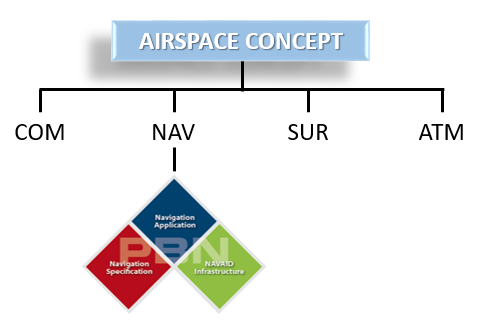An airspace concept describes the intended operations within an airspace. Airspace concepts are developed to satisfy explicit strategic objectives such as improved safety, increased air traffic capacity and mitigation of environmental impact. Airspace concepts can include details of the practical organization of the airspace and its users based on particular CNS/ATM assumptions, for example ATS route structure or a routeing schema where users define their own flight path, separation minima, route spacing and obstacle clearance. Therefore, the heart of any airspace concept is airspace design.

Strategic objectives such as safety, capacity, efficiency, access and the environment drive the general vision of the airspace concept. These objectives are usually identified by airspace users, ATM, airports as well as environmental and government policy. It is the function of the airspace concept and the concept of operations to respond to these requirements.
Within an airspace concept, PBN requirements will be affected by the communications, ATS surveillance and ATM services, the NAVAID infrastructure, and the functional and operational capabilities needed to meet the ATM application. PBN requirements also depend on what reversionary, conventional navigation techniques are available and what degree of redundancy is required to ensure adequate continuity of functions.

The airspace concept is developed to fulfil the strategic objective(s); however, to meet the objective(s) the concept will place requirements on the various “enablers”, such as communications, navigation, ATS surveillance, ATM and flight operations. The required navigational capabilities will need to be identified. These functionalities are formalized in a navigation specification which, together with a NAVAID infrastructure, supports a particular navigation application. No “enabler” can be developed in isolation, i.e. communications, ATS surveillance and navigation enablers should form a cohesive whole. Therefore, the airspace concept brings all these elements together in a cohesive whole.
Therefore, the Airspace Concept as a formal way to set out and respond to airspace requirements. As such, the development of the Airspace Concept is a key step in PBN implementation. From an ANSP’s perspective, PBN is one of several enablers of the Airspace Concept. From an aircraft and air crew perspective, PBN clarifies and provides a uniform structure to requirements for airworthiness certification and operational approval for use of area navigation systems in airspace implementations.
Once fully developed, an Airspace Concept provides a detailed description of the target airspace organisation and operations within that airspace and can, when complete, be anything from five pages in length (for extremely simple airspace changes) to a document of several hundred pages.
The interdependence between CNS enablers is particularly relevant when determining a route structure for an Airspace Concept. The configuration and spacing of PBN ATS routes in an independent surveillance environment enables optimum route configuration and reduction in route spacing when compared to a procedural environment (where reliance is placed ‘exclusively’ on Communication and Navigation performance).
However, GNSS can be a common point of failure to communication, navigation and surveillance. This is important when considering airborne and ATM contingency operations as well as infrastructure optimisation. .Although GNSS is associated primarily with navigation, GNSS is also required for ADS-B surveillance applications. As such, GNSS positioning and track-keeping functions are no longer “confined” to being a navigation enabler to an airspace concept. GNSS, in this case, is also an ATS surveillance enabler.
The development and implementation of a PBN-based Airspace Concept makes significant contributions in terms of safety, environment, capacity and flight efficiency. For example:
- PBN’s partnership approach to developing the Airspace Concept ensures that conflicting requirements are tackled in an integrated manner and that diverse interests are addressed without compromising safety, environmental mitigation, flight efficiency and capacity requirements;
- Safety is enhanced by ensuring that the placement of ATS routes and Instrument Flight Procedures service both Air Traffic Management and Obstacle Clearance requirements;
- Environmental mitigation can be improved by granting environmental needs the same level of importance as capacity enhancement when defining the operations in an airspace and affecting the airspace design.
- Capacity and Flight Efficiency are enhanced by placing ATS routes and Instrument Flight Procedures in the most optimum location in both lateral and vertical dimensions.
- Access to airports is improved particularly in terrain rich environments.